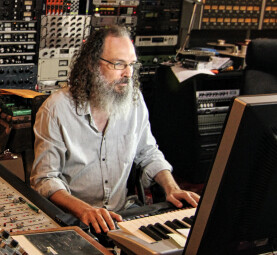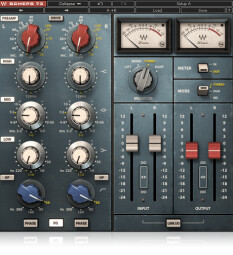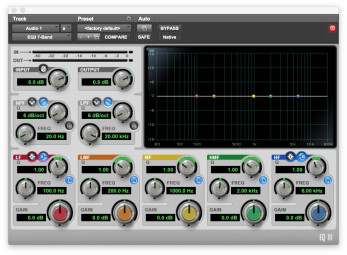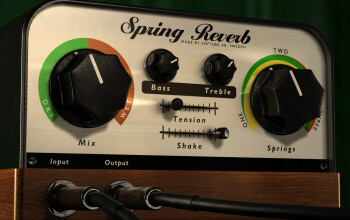Welcome to Part 2 of our interview with renowned mix engineer Andrew Scheps. This time around, Scheps offers more details on his mixing techniques, and talks about why he transitioned away from his previous console-based setup and into mixing in the box.
If you read part 1, you’ll know that Scheps is a master of the technique of parallel compression, and uses multiple compressor chains, many on aux busses, in all his mixes.
We kick things off talking about placement of elements in a mix.

People talk about a 3D soundstage when mixing. Panning is left to right, volume and ambience move things forward and back, and — according to some — you can move things up and down with EQ. Do you think that way?
No, I have no idea what I’m doing in those terms. Sometimes I wish that I could go, “I would like to move this to the back now, ” but other than adding a delay or reverb, I don’t really know how to do it. But I’ll sit in front of a session for three hours and feel like I haven’t done anything, and I’ve done 25,000 tiny things. And then all of a sudden it’s like, ”OK, that doesn’t sound terrible anymore." And then I’m on my way. So, yeah, I really have no idea what I’m doing when I’m doing it. When things are going well it’s a sort of creative trance.
What about EQing? Are you thinking, “I’m carving out a space for this, because it’s overlapping something else frequency wise?”
No, only if there’s a real problem do I approach it that way. But I would rather use EQ than volume sometimes. If you’ve got a lot of stuff in the same space, it’s much easier to grab an EQ, and EQ it while you’re listening to everything, and make it pop out. Because if you start to turn it up it obliterates other stuff.
Can you give an example?
Let’s say you’ve got a dense rock track, which has a solo section. You’ve got all the stuff that you had leading up to the solo, and now all of a sudden you have this massive guitar, and you have to figure out how that’s going to fit. So that’s kind of an isolated EQ pass. But most of the time it’s just trying to find a way to make it pop out. Panning is another way to approach it.
So you’re not just turning up the solo so it’s a little louder than the rest of the instruments in the mix?
For me, no, because what will happen is that it will start to hit all the parallel compressors a little harder and everything else will sort of disappear a little bit. And I don’t want to lose any of the punch of the drums. The kick and snare need to still be as punchy as they were in the chorus leading up to that solo, but now I’ve got this big blanket of guitar over the top, so I can’t just push it, because it will start to push everything else down.
But everything isn’t going through the same parallel compression chain, right?
A lot of them are shared. And then also, it starts to hit your 2-mix harder, and that starts to push it down. Because the mix can only be so loud going through that stuff, if I can find a spot for it. Let’s say it’s a guitar solo, it’s going to be somewhere in the midrange, which is the important part of it. And if you can hear that, you now have an apparent huge guitar tone. If you can’t hear it, it doesn’t matter how loud it is, it sounds tiny, even if it’s obliterating everything else. So, as long as you have other stuff filling up the spectrum around it, you don’t really need to make the big stuff big, it just needs to be in the right spot.
What about ambience? Like on vocals? Do you have any particular ways you approach that?
I don’t actually do much. I think I spent enough years mixing for Rick Rubin, who likes stuff really dry, that I kind of got out of the habit of doing it. And then sometimes, I’ll get tracks to mix and the session is already built up with a bunch of vocal effects and it’s really cool, and so I’ll keep them and maybe add a couple of things. But usually, I just have a slap somewhere in the 110 ms range. I’ve got a very short reverb — either a plate or a room or something somewhat natural sounding. And then I’ve got a very short stereo delay with a little bit of pitch shifting. And even with all that stuff in the mix, you’d probably thing the vocal is bone dry. But if you soloed it, and took that stuff off, it would be like, “Oh, now that’s dry.” I wish I were better at using vocal reverbs, because when I hear stuff where it’s done well, it’s just amazing. But I have a really hard time doing it. It always sounds artificial to me.
Previous to your new Parallel Particles plug-in, you collaborated on another Waves plug-in, the Scheps 73, a Neve 1073 emulation. What was the genesis of that one?

It came about because they’d been doing all these Artist Series plug-ins, with Jack Joseph Puig and Chris Lord-Alge and all those guys. So they talked to me about doing one, and I really wanted to do something with the way that I use parallel compression. Because I think it’s become much more common now than it was ten years ago or so to use so many shared parallel compressors. But it turned out that it was technically almost impossible to do as a plug-in suite, because you needed plug-ins on inserts controlling other plug-ins on auxes. It was a really complicated thing and we could never really figure out what to do. And then they decided that they wanted to circle back around and remodel the Neve EQ, because they’d done the V-EQ years before. And I think that may have been one of their first modeling projects, and obviously, modeling has gotten ridiculously great lately.
So why the 1073?
They knew I was a huge Neve fan, and that I owned ten of them and a BCM10, and did we want to work together on this. And so we did. And it was a really cool thing too, because instead of me just saying, “Yeah, this is my favorite 1073, make a plug-in that sounds like that, ” they said they had one that they thought was amazing. And I said “Great. I’ve got ten and I like them all, and I don’t know if I have a favorite. Let’s just make your model sound like all of mine.”
Wow, ten 1073s.
So instead of having a quirky one, that turns out was actually a little bit broken, we got, I think, a really representative 1073 with all of the input transformer dirt, all of the preamp dirt — that harmonic distortion you can get as you start to crank it up…Anyway, it was a great process, they’re just ridiculously smart over there. I just kept getting plug-ins with like 500 little text boxes, and they’d say, "OK, don’t touch those 498 — those two are the ones we need you to tweak and tell you what values you like. And I’d do that, and we’d tweak the harmonic distortion every harmonic.
What, in particular, is so desirable about the sound of a 1073?
The EQ itself is just really, really, musical. Other than the high-pass filter, it’s the kind of EQ I never cut on, I only boost. And all of the frequencies were chosen by musicians. Every model of Neve was custom-ordered by somebody. And so the 1073, I don’t know who they were working with, but Abbey Road and all the studios that were ordering consoles at the time would say, “Yes, I would like that EQ, but I would like the shelf to be 12 kHz instead of 10.5 kHz, and I’d really like 360 [Hz] at the bottom of the midrange.” And the one that they actually modeled was a 1078, which was exactly like a 1073, but it had 10 kHz in the midrange band. And this is before parametric EQs. So you had to choose the frequencies that you thought you’d always want to be able to EQ at. And as it turns out, they’re really well chosen. Like, “I want to [EQ] the midrange on the piano.” One of those two midrange frequencies is going to be perfect on every single piano you ever try to EQ.
Cool.
That’s what’s great about it. And the shape of the bell, and the shape of the shelves are all done to just sound musical. And on top of that, it’s a great sounding preamp. Obviously on a plug-in, you can’t get a microphone in there to take advantage of all the gain, but you can get that harmonic distortion, which is what I really like. When I’m recording on the hardware, I’ll always crank the mic pre one click past where you probably should and drop the fader down, because that’s when you really start to hear the “Neve sound” of it.
And you can get that sound from the plug-in?

Yeah, it’s all there. We built the preamp in there so that as you turn it up, you’re actually bringing up the harmonic distortion but not the level. So you don’t just trick yourself into thinking it’s better, you can actually A/B and take the preamp in and out and decide if you like it. And then you also have the option to put it in mic input mode, but shove a line-level signal into it, so you can really get some very buzzy weird distortion. It’s not my favorite preamp to distort, but it’s a specific sound, and if that’s what you want, then you’ve got it.
What other plug-ins do you use a lot when mixing?
There’s a lot. At the moment, I’m using the Waves Kramer HLS, the Helios EQ. Because it’s a totally different sounding EQ, and you barely touch it, and it just sort of resonates at the frequency you set it at. I love the midrange on that for guitars a lot. I still love the Pro Tools EQ III.
Really?
I use it all the time. For surgical EQ, and being able to solo up the band very quickly. The fact that it has incredibly low DSP usage and low latency, and it just sounds exactly like what it needs to do. And if you need clean high-pass and low-pass filters, they’re really good. If you want dirtier filters, I love the McDSP FilterBank F202, because it’s got resonance that’s separate from the slope. So you can have a very gentle slope in your low pass, but crank up the resonance. You get this great hump, but then leave some top end. You kind of get two curves in one on there.
What else?
1176 plug-ins — all of them.
Do you think most are pretty accurate to the original units?
Not necessarily, but it doesn’t matter, because it’s the same family of compression. And in hardware, I love the 1176, I used it a lot, so I know it, and I can get the same sort of thing. Once you get to the extreme settings, they’re all different, but all the hardware is different too, so, that’s fine. While they sound different, it’s definitely in that family. And I’m not trying to replicate hardware, I’m just trying to get a sound.
What about reverbs?
I love AltiVerb, because I’ve got a lot of things I’ve sampled, plus their library is huge and ever-growing. So that’s sort of inspiring that every time you put the plug-in on there are more IRs avaialble. You might find something cool. I’ve actually been using Waves TruVerb lately, because I’m trying to find a really short-but-not-too-dense natural-sounding room. The UAD 250 is really good. I like that one. The Valhalla reverbs are really cool, the Shimmer is awesome. But, like I said, I don’t use reverbs a whole lot.
What about on other elements, like drums?
I love spring reverbs. I love the SoftTube Spring Reverb, that’s a good one. But for my drums I create the sort of sense of a drum room, with distortion. I use the iZotope Trash plug-in with a ton of EQ before and after it. So that gives me what sounds like a room, but it’s not. Whenever I put reverb on it, it just sounds like I put reverb on it.
Do you use plug-ins that create harmonic distortion — tape simulators and things like that?

Every once and a while. I usually use them on a specific element. I don’t tend to use it on the mix or use any of the full console emulations. It’s just like with HEAT in Pro Tools. It just feels like too much to me. On a console, I was always fighting to keep my mixes clear, because I was picking up so much of that harmonic distortion. So to be free of it in a way is actually cool. And that way, I’m only putting it on the stuff I want. Like I use Lo-Fi, Lo-Fi is actually one of my favorite plug-ins. And I use it on all kinds of things, but just a tiny bit, and only on the things that I want. So it’s almost an extension of the tracking stage, where I’m making a particular instrument sound the way I want it to sound. But once I start combining them, I just want them to still sound that way. I’m not looking to pick up a bunch of color along the way while I’m summing. It’s just personal preference. There’s certainly no right or wrong with it.
A lot of mix engineers say that in-the-box mixing is lacking something — that it’s not three-dimensional enough. They have to go through a summing amp, or a mixer to get the sound they want. How do you respond to that?
[Laughs] Well, it’s a little contentious, apparently. I went on Pensado’s Place about a year ago and said “I’m mixing in the box now.” And then there was some 25– or 30-page thread on GearSlutz. There were some people that said I was lying, that I still mix on the console, and that I said that I mix in the box because I want to sell plug-ins, which I thought was really funny. My theory is that I started moving away from the consoles because of logistics. But there were also some sonic things that I was fighting, because my mixes are so loud, and analog gear, when you hit limits, really starts to fall apart, which doesn’t happen in a floating-point mix where you can just turn it down after the fact. And anywhere in your signal path you can grab it and fix it and still keep the crazy compression you had going on at the beginning of the chain, but make it fit into the mixbus later on. You can’t do any of that in the analog world.
That’s for sure.
And I was really starting to fight it where my mixes would not fit through the mix bus chain I was using Neve compressors and a pair of Lang EQs. And the Langs just could not take the level. But I tried a ton of other EQs and I didn’t like anything else. So it was not like I had this amazing world, but the workflow didn’t work. There was plenty of stuff I was fighting. Not to mention the fact that the console sounds different every day, and if you do a recall, none of the knobs ever go back where they’re supposed to, and it never sounds better, it always sounds worse for whatever reason. So that was my impetus for going in the box, but I wouldn’t do it if I didn’t think that it sounded as good. And I think that it sounds absolutely fine to mix in the box. There’s nothing about it that’s not good now. And I mixed in the box for years before I ever had a console. And in between, I had a Mackie analog 8-Bus and a Digital 8-Bus, and you know, every sort of configuration that you could have. And then I was in the box with a ton of analog inserts. And then I bought a Neve so, “Great, now I have a console.”
Why do you think some people don’t like mixing in the box?
I think there are two things: I think some of the people that don’t want to do it, don’t want to because they don’t know Pro Tools — or whatever their DAW is — well enough. When you’re using it like a tape machine with some plug-ins, you don’t have to know it that well. It’s fine to just sort of know it. But if you’re going to mix in the box, you’d better know it inside out. Because there are a million things that will make your life difficult if you don’t know them, and will even destroy your mixes if you don’t understand them.
Such as?
Like the way the floating point architecture works, and being able to use master faders for your 2-mix that will turn down a problem that you created on your kick drum track like fifty faders away. You know, all that kind of stuff. So that’s part of it. The whole analog summing thing, some people love it, and that’s great. I tried it, and I tried it on my Neve, I tried it with some passive summing mixers and with some active summing mixers, and I didn’t like it as much as not bothering. My theory at the moment is that once it’s in the box, I don’t want to take it back out. I don’t want to go through D/A converters, because D/A converters sound like stuff, and it also commits any audio problems that I created up until then. If it’s clipping coming out of that converter, it’s clipping forever.
Good point.
If it’s clipping coming out of the Pro Tools mixer, just turn it down and it’s no longer clipping. And also, if you sum it analog, now you’ve got your loud mix again, and now you’ve got to fit that back into the A/D converters. So forgetting about the digital side of things, you’re also right up against the rails of the analog side. All of those things degrade the signal as much as getting some harmonic distortion out of a summing mixer might enhance the signal, and the tradeoff wasn’t worth it for me. I thought I was getting a better sound in the box.
